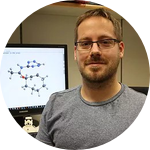About This Project
Raspberry Pis, inexpensive and versatile single board computers, have found their way into science and chemistry. The increased computing power raises the question of whether they can be used in computational chemistry. First, we want to investigate their use as a teaching tool; providing an inexpensive cluster environment. Second, we want to determine if such a cluster has the computing power to allow for state of the art computational organic chemistry research.
Ask the Scientists
Join The DiscussionWhat is the context of this research?
Computational chemistry is becoming an indispensable tool in chemistry research. While in the past expensive supercomputers were needed to conduct such research in an efficient way, with the increase in computing power this branch of chemistry became more accessible, allowing for projects beeing performed on personal computers.
In this project we want to go a step further and assess if and how a cluster of the newest generation of the beloved and inexpensive Raspberry Pis can be used in teaching computational chemistry. An additional goal will be the investigation into the provided computing power and a comparison with x86 PCs of similar cost.
What is the significance of this project?
While access to big amounts of computational resources is easier then ever, a lot of chemistry departments around the world, and especially in developing countries, do not have access to high performance computing facilities.
This project will investigate if an inexpensive (~$1000) 8-node cluster of Raspberry Pis can be an alternative to introduce students into the world of computational chemistry on clusters and provide a guide for others. The question if such a cluster provides an adequate computational power to conduct computational research can help deciding the most cost effective solution.
What are the goals of the project?
The project consists of building a 8-node cluster. Afterwards it's use in teaching undergraduates the basic of computational chemistry on a cluster (cluster usage, schedulers, parallel computing) will be assessed and a guide will be published.
Furthermore, the computing power of the cluster will be investigated using various benchmarks and compared to other systems. The evaluation will be focused on the performance per cost ratio. Guides for performing such calculations on a Pi cluster will be produced.
Parts of the cluster will also be open for the public via the WebMO interface.
Based on the available computing power a small project will be realized using the cluster exclusively.
Afterwards, the cluster will be used in a school without access to a HPC facility.
Budget
The budget will be used to create a Raspberry Pi cluster consisting of 8 nodes.
Raspberry Pi 4 Model B in the 4GB RAM version were chosen for best peformance. An 8 port ethernet switch is used to connect these Raspberry Pis to a cluster. Micro SD cards (1 per Raspberry Pi) are used for local storage while a 1 TB external SSD will be used as mass storage.
Other parts involve ethernet cables for connecting the Pis to the switch, heatsinks for each Pi to provide adequate cooling, a power supply and cables to power all Pis and a case.
Fees and taxes are included.
Endorsed by
 Project Timeline
Project Timeline
The project is expected to be finished within a year, including dissemination of the results.
Mar 01, 2020
All parts needed for the project are acquired.
May 15, 2020
Building of the cluster is finished. This involves the physical setup of the cluster as well as the installation of the needed software packages.
Jul 15, 2020
Finishing the evaluation of the cluster as a research tool by teaching undergraduates on the Pi cluster and evaluating how the acquired skills transfer to full clusters.
Nov 15, 2020
Finishing the evaluation of the cluster as a research tool by performing two small computational organic chemistry projects
Jan 15, 2021
Results will be disseminated in open access form after all evaluations are performed.
Meet the Team
Dennis Svatunek
I am a trained organic chemist who turned to computational chemist. My research interests involve pericyclic reactions, especially those that can be used in living systems (bioorthogonal chemistry). I'm also a computer enthusiast currently exploring the use of personal computers in computational chemistry, which makes this exciting field more accessible.
This project would allow me to go a step further and find out of Raspberry Pis can be used as well.
Lab Notes
Nothing posted yet.
Additional Information
Gamess-US will be used as quantum chemistry software. Ernst Schumacher has shown that this software can be installed on a Raspberry Pi 4 Model B. He also showed that the computing power of a single Raspberry Pi 4 is good enough to run smaller jobs. (https://www.chemsoft.ch/qc/raspigamess.html)
In addition, NWChem 6 is now available on Raspberry Pis.
Project Backers
- 0Backers
- 0%Funded
- $0Total Donations
- $0Average Donation

